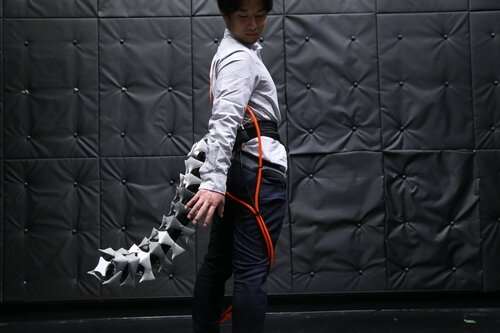Why would a fairly sane person want to walk around with a robotic tail? Getting technical (or clinical) there are plausible reasons posed by three researchers in Japan, and they are getting much attention.
Their design is for bio-mimicry inspired tails that can be worn by humans, they say, to extend body functions. A video posted in May introduced Arque, an "anthropomorphic" tail.
Regarding help for individuals needing support to maintain balance, they explained in their paper that "the force generated by swinging the tail" can change the person's center of gravity position. "A wearable body tracker mounted on the upper body of the user estimates the center of gravity, and accordingly actuates the tail."
Why even think in terms of a tail for humans unless it is for a costume party or Halloween?
The three creators behind this are from Keio University's graduate school of media design. They are Junichi Nabeshima, MHD Yamen Saraij and Kouta Minamizawa.
While numerous sites describe the tail as a "wearable" how likely would it be for people to feel comfortable putting one on?
Fast Company, for starters, said it remained to be seen if a robotic tail will ever be socially acceptable enough that someone would use it rather than a cane.
The researchers pointed to those animals that rely on their tails for mobility and balance. "In some situations our bodies may lack the ability to support or balance us," said the video presenter. Climbing high cliffs, lifting heavy objects, would be some examples where people could derive support from the tail.
"The tail prototype, called Arque, is based on a seahorse's tail and uses a series of artificial vertebrae and four pneumatic muscles to move," said The Telegraph.
The team, in their paper, noted the reasons why the seahorse tail was their source of inspiration, namely its structure.
"In this prototype, the tail unit consists of a variant number of joint units to produce. Each joint consists of four protective plates and one weight-adjustable vertebrae. At each joint, the plates are linked together using elastic cords, while the vertebrae are attached to them using a spring mechanism to mimic the resistance to transverse deformation and compressibility of a seahorse skeleton, and also to support the tangential and shearing forces generated when the tail actuates."
As they indicated, Arque's length and weight can be adjusted to accommodate the wearer's body.
Zoe Huxford in Dazed Digital weighed in with a comment that, "although it looks ridiculous, it has the potential to do pretty amazing things; it could be used to assist the elderly with mobility, prevent them from falling over, support laborers when they're moving heavy loads and be incorporated into a balance rehabilitation program."
This bio-inspired tail concept was made known this year at the Computer Graphic Convention SIGGRAPH 2019.
While "equilibrium maintenance" served as a key benefit, another application possibility was raised by the team, and that was wearing the tail for full-body haptic feedback. Think virtual reality. "A different approach for using the tail other than equilibrium maintenance is to change the center of mass of the user to off-balance posture. This can help to generate full body forces depending on the point of attachment of the tail, and can be used with applications such as in virtual reality."
Luke Dormehl in Digital Trends commented on the Arque tail as a serious tool for work. "Similar in concept to the wearable exosuits developed by companies like LG,," he said, "the idea is that this could be used to help workers to lift and carry heavy items by giving them a counterbalance."
Arque: Artificial Biomimicry-Inspired Tail for Extending Innate Body Functions is in Proceedings of SIGGRAPH '19 Emerging Technologies. ACM.
More information: Junichi Nabeshima et al. Arque: artificial biomimicry-lnspired tail for extending innate body functions, ACM SIGGRAPH 2019 Emerging Technologies on - SIGGRAPH '19 (2019). DOI: 10.1145/3305367.3327987
© 2019 Science X Network






















